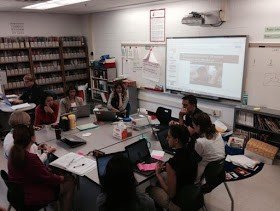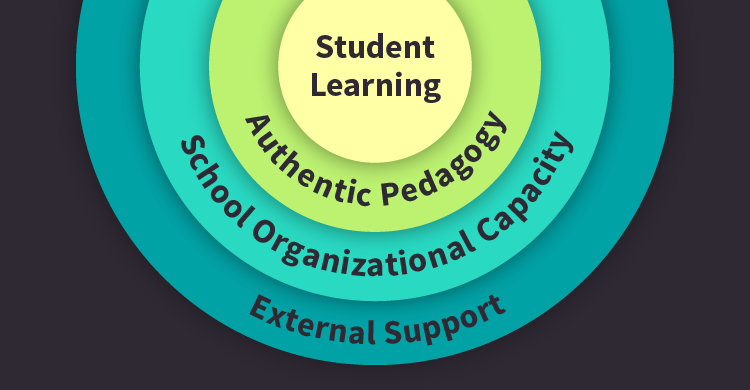(This is a guest post from Dr. Angel de Dios, a parent of a student at Mason Crest Elementary School, a recognized Model PLC.)
Actions are supposed to speak louder than words, but words are seen in media much more often. Worse, society with its limited attention span and general lack of critical thinking is now at the mercy of sound bites. What works in education is therefore frequently missed as a careful and thoughtful attention to details is usually absent.
Twenty years ago, the Center on Organization and Restructuring of Schools published a report synthesizing education research to find what it takes to reform schools successfully. The main authors of the report drew the following diagram to highlight what is necessary for improving schools.
 |
| Above copied from: Successful School Restructuring. A Report to the Public and Educators by the Center on Organization and Restructuring of Schools Fred M. Newmann and Gary G. Wehlage |
At the center, the main goal or focus must be student learning. This vision alone, however, is not sufficient. The first layer required to achieve this goal is, of course, teaching (or pedagogy). This component requires research- and evidence-based approaches that promote high quality learning. It starts with proven or promising practices that can be implemented by a teacher inside a classroom. These practices therefore require a teacher who is competent. Higher quality student learning as well as authentic pedagogy place a high demand on teachers. The school therefore must be organized in a way that helps a teacher meet these challenges. Finally, parents, administrators and the community, in general, need to be on board.
It takes about a paragraph and a diagram to describe roughly what is needed to reform schools successfully and yet, the message here is still quite long. There are clearly quite a number of factors. It helps to look at one factor at a time. For this purpose, a picture may help. The following photo is from Mason Crest Elementary School.
 |
| Above copied from: The Facebook page of Mason Crest Elementary School |
The photo came with the following description:
“As a School that embraces the Professional Learning Community at Work process we abandon the idea of the isolated classroom teacher and create collaborative teams who take collective responsibility for ensuring that all students learn at high levels. The picture shows a weekly hour long language arts planning meeting where the fourth grade team (10 teachers) are planning together to ensure that everyone deeply understands (the curriculum) what it is all students are to learn. Each grade level has one hour of math and one hour of language arts planning each week!”
The study from the Center on Organization and Restructuring of Schools actually points out that one way to enhance a school’s organizational capacity is to shape schools into professional learning communities. Schools unfortunately do not become professional learning communities overnight. Success depends on human resources, leadership, and favorable structural conditions.
One obvious structural condition is time. Teachers require time to meet and work together. In Mason Crest Elementary School: Each grade level has one hour of math and one hour of language arts planning each week! That statement came with an exclamation point. In addition, teachers would need more time with their students in their classroom to assess better where the students are. After all, student learning is the main agenda in these meetings.
This need for time is highlighted in a recent report from the National Center on Time and Learning:
 |
| Above copied from: National Center on Time & Learning |
Likewise, the Center for American Progress points out that teacher collaboration happens more readily in schools with expanded learning time (ELT).
 |
| Above copied from: Center for American Progress |
“By providing more time for teacher collaboration and more time for students to grasp difficult content, high-quality expanded learning time schools are already succeeding in the early stages of implementing the Common Core. These schools are using the extra time to prepare teachers for the transition to the new standards and curricula and are devoting their additional class time to richer instruction and deeper, more personalized learning—exactly the kind of learning that the standards are designed to deliver. The potential wide-ranging effects of expanded time on schools—from increasing time on task for individual students, to enabling a much broader and deeper set of learning activities in classrooms, to facilitating the development of effective professional learning communities among teachers—make it clear why a well-designed ELT school is so well-positioned to successfully implement the Common Core. As states, local school districts, and schools confront Common Core implementation and consider options for moving forward, we strongly encourage them to consider the benefits of expanding the school day or year to support teachers and students.
Obviously, time is only one of the important factors. A successful professional learning community cannot flourish without autonomy and authority. Teacher collaboration cannot thrive without mutual respect and interdependence. Providing time is, of course, a good place to start. A school that gives adequate time and support for teachers to work together and learn from each other is a school that takes student learning seriously. How much time and effort we devote on a task can sometimes be taken as a measure of our commitment. In the case of improving schools, this is apparently true.
[author_bio id=”guest”]






